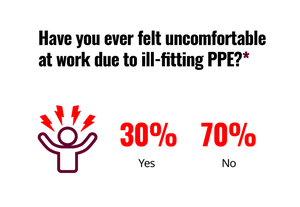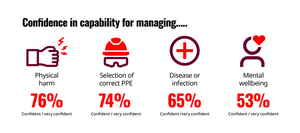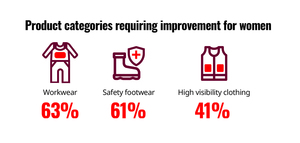
 |
Mark Sennett
Managing Editor |
 |
Kelly Rose
Editor |
| Home> | Industry Update | >Company News | >Protect what matters - May 2025 |
| Home> | PPE | >General PPE | >Protect what matters - May 2025 |
Protect what matters - May 2025
29 April 2025
A new report from RS offers a snapshot of key issues affecting the health and safety landscape.

HEALTH AND safety is an evolving and fast-paced landscape with legislative changes and industry trends keeping industry professionals across all sectors on their toes. A variety of challenges face the profession around maintaining compliance and nurturing the right culture to achieve this; addressing the importance of mental health and wellbeing; and keeping employees safe and comfortable with fit-for-purpose personal protective equipment (PPE).
Those working in health and safety really must stay abreast of the latest information and innovations, explore and discuss key issues and share insights.
To help provide a snapshot of the state of play in the health and safety (H&S) profession now, including the challenges and priorities for those at the heart of it, RS conducted its third annual industry survey. From this, it created the 2025 Health & Safety report ‘Improving the Standard’, based on responses from 545 people working in H&S roles in the UK and Ireland.
The focus sectors included manufacturing – in markets like food and beverage, automotive, pharmaceuticals, industrial machinery, plastics and chemicals – and energy and utilities, public services and logistics and retail.
The report covers three key areas for H&S professionals: the management of Environment, Health & Safety (EHS), business strategy and compliance, and factors affecting the future of health and safety in the next 12 months. Additionally, this year RS conducted separate research among 196 customers, all users of PPE, to unveil some end-user perspective.
Focus on increasing confidence is needed
RS’ report highlighted falling confidence among EHS teams in their ability to keep staff safe and do their jobs effectively. The highest area of confidence is in managing protection from physical harm, where 76 per cent of respondents said they felt confident or very confident. The figures were similar for PPE selection at 74 per cent, but in areas like protection from disease or infection and mental health and wellbeing, the numbers were lower at 65 and 53 per cent respectively.

The overall levels are reasonably high, but many metrics have fallen to their lowest in three years. Could this mean there’s a growing unease in the minds of health and safety professionals?
Raj Patel, managing director for RS in the UK and Ireland, said: “The results around confidence paint a mixed picture; while there is still a reasonably high level of confidence in the ability to protect people, and the systems in place to achieve this, reported confidence levels are nevertheless at their lowest since this report was first released, and this is common across several metrics.”
Although the report states that, encouragingly, there’s no evidence that there is an impact on confidence in the ability to protect end-users, which has remained relatively stable at 88 per cent, reflecting the job EHS professionals are doing to ensure people are safe at work.
When it comes to mental health concerns, the 53 per cent of professionals who cited they are confident in how they perform when it comes to mental well-being is down from 55 per cent the previous year, and at the same level as in 2023.
The RS report highlights some steps organisations can take to address the key issue of mental health and wellbeing.
One is to undertake a mental health risk assessment to identify how big an issue this is for the organisation. And, if one isn’t already in place, develop a mental health strategy and cultivate a culture where people feel comfortable in raising issues. Every organisation needs a champion to make the case against cutting back on such initiatives to reduce the risk of complacency.
Measurement is key
KPIs are key for many organisations now in measuring performance against goals, but nowhere is it more important than when measuring health and safety compliance. Not doing so, in areas like accident rate, could affect the capability to reduce or manage risk.
The RS report highlighted a downward trend in how organisations measure compliance. More than seven in 10 record their all-accident rate – down slightly from 73 per cent – while 61 per cent measure near-miss rate, down more significantly from 67 per cent. Other metrics are also down, like those measuring observations around behaviour-based safety, from 59 per cent to 56 per cent. Organisations monitoring the number of training hours is also lower, down from 45 per cent to 39 per cent.
John Barnacle-Bowd, vice president for EHS at RS Group, said: “If you’re not measuring it, you’re not managing it. Maybe an accident incident reduction can make it fall off the agenda. But what happens when they do have an accident? And does not having a KPI lead to that complacency? Complacency kills.”
RS advocates having a strategy in place to cover the major causes of accidents that goes beyond the minimum acceptable level required by law, and putting a focus on what good looks like rather than failings. Consistent engagement management in health and safety will help deliver cultural change throughout the organisation, while reviewing KPIs to ensure they remain relevant to the organisation and cover the main risks, is advisable.
Future challenges
Skills shortages remain a real concern for the survey respondents, who believe more needs to be done to boost the image of the sector, as well as placing an importance on retaining talent.
As well as feeling under pressure from budget restrictions and the need to improve productivity, respondents believe sustainability will remain an important topic and challenge in the next 12 months. However, there’s a growing reluctance to pay more for such products. The survey highlighted a drop in willingness to pay more for a sustainable product, from 78 per cent last year to 60 per cent of health and safety professionals this year. Looking at lifetime costs can help businesses achieve better outcomes without over-stretching budgets.
Women’s PPE remains a key issue, with 85 per cent believing more needs to be done to ensure PPE is suitable for women in terms of better fit, size and suitability. However, despite a growing awareness of women’s PPE options, only one per cent cited women-specific PPE as an important factor when sourcing.

Counterfeit and sub-standard items saw 34 per cent of respondents citing concern about this, compared with 37 per cent a year ago. RS urges organisations to seek kitemarks to prove items are manufactured to British or international standards.
A new perspective on end users
While the RS survey respondents are all health and safety professionals, this year additional research on PPE end users was conducted to offer a new perspective on their experiences.
Some 11 per cent of respondents said ill-fitting PPE had made them feel unsafe or unprotected in the workplace.
A significant 30 per cent said it had made them uncomfortable, with 13 per cent saying they’ve had to modify it to fit. Of those respondents, 20 per cent said they had raised the issue with a line manager and in 79 per cent of those cases, suitable PPE was sourced.

Health and safety professionals have a difficult job to do. In difficult economic times costs are rising and there are ever-growing wider geopolitical uncertainties. Organisations must try not to be tempted to cut corners or let complacency creep in.
Navigating a turbulent landscape while wrestling with the broader issues is no mean feat. EHS professionals should look to work with a trusted partner that can help, both with identifying what is required and how best to achieve the desired outcome.
RS’ report ‘Improving the Standard’ can be downloaded in full by visiting https://uk.rs-online.com/web/content/m/hs-industry-report.
- Share your view on the challenges the sector is facing
- Protect What Matters - June 2024
- Protect what matters - March 2025
- Carbon neutral products that don’t cost the Earth
- An inside view
- RS Safety Solutions achieves AA rating
- Fetching solution for dog food manufacturer
- Protect what matters - December 2024
- Time for a tailored approach
- Sustainable goals


























